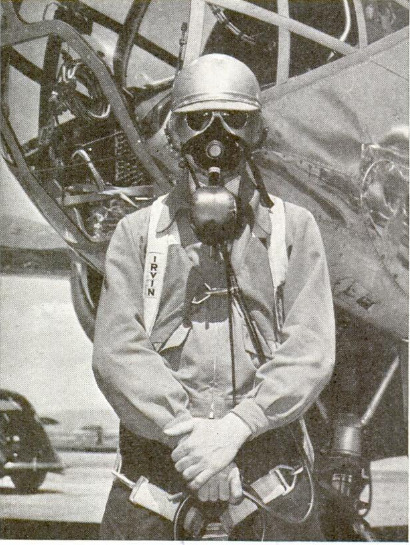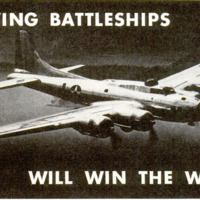WINSTON CHURCHILL appeared before Congress last December and declared that the Allies would be ready “to take the initiative on an ample scale” by 1943 and in the end would give the Axis powers a lesson the “world will never forget.” There is no doubt that he was thinking largely in terms of air power. By 1943 American factories will be producing hundreds of four-motored bombers each month, and these mighty “air battleships” may well be the deciding factor of the war. Two and one-half years of aerial warfare in Europe and several months fighting in the Pacific have indicated that the nations which first acquire a fleet of long-range, hard-hitting planes will win final victory. Boeing’s first Flying Fortress was produced in 1935. Even hough it cracked up in a takeoff, the Army immediately ordered thirteen more. In 1941, the United States sent a few big bombers to England. They were promptly dubbed “flying targets” Too big, too slow and too costly to build was the snap judgment on them at first. But when R.AF. pilots took the American-built air battleships over the European continent and dropped bombs on Germany, they came home singing their praises. Last July the British Air Ministry revealed that Boeing Flying Fortresses had staged daring daylight raids on docks where German pocket battleships were berthed at Brest. Flying at 30,000 feet, the big planes could be neither seen nor heard. Antiaircraft fire couldn’t reach them and fighter planes were ineffective at that height. Instead of carrying 250 -pound bombs, the Flying Fortresses carried what Lord Beaverbrook described as “big, beautiful bombs” of 1,000 to 2,000 pounds. Right then the character of World War II underwent a drastic change. Germany frantically began to convert its Kurier, a large transport, into a long-range bomber. The British stepped up production on their big Stirling and Halifax bombers. But it remained for the United States, whose engineers had been building big bombers for six years, to undertake the most gigantic task of all. Plans were adopted to hit a production schedule of several hundred air battleships a month by 1943. Such a job calls for the brains and brawn of 500,000 men. Almost overnight Boeing, Douglas and Vega - a subsidiary of Lockheed - pooled resources and facilities for building Flying Fortresses, each to turn out completely assembled four-motored bombers, with complete exchangeability of parts. In addition, Consolidated Aircraft Company arranged to speed production on its four-motored bombers and the Ford Motor Company’s Willow Run plant moved rapidly toward the day when mass production might be achieved. Both the new Boeing and the Consolidated ships have more fire power, carry a heavier bomb load and provide more armor and selfsealing gas tanks than did earlier models. Radio locators help to spot enemy fighters. Several machine guns bristle from powered turrets. The bombers are able to lug several tons of bombs on a 2,500-mile trip at exceptionally high speed. Planes such as these are the first to combine the three necessities of modern military power - great striking range, great speed and great carrying capacity. Up until now, modern air fleets have resembled navies consisting only of destroyers and cruisers. There have been few “air battleships” to deliver the decisive blows. Almost daily dispatches from the war fronts indicate that aerial battlefronts are on the move - up. Combat at 25,000 feet and above in Europe has already taken place. Greater heights will become common as the four-motored hombers get into action. Germany is said to have a Messerschmidt fighter plane capable of reaching 39,000 fect. At 35,000 feet, the air is so thin that a man becomes unconscious in less than a minute without artificial air supply. Conditions such as these require not only precision engineering but careful training of flight crews. At the Boeing plant much attention has been devoted to this phase of stratosphere warfare. Using its “strato-chamber,” the first extensive stratusphere conditioning tests to be carried out on a large group of men were undertaken several months ago. Whole test crews have made experiments both in the laboratory and in the skies to gather data on flying conditions in the “purple twilight” of the upper atmosphere. America’s four-motored bombers will outperform those of any other nation because of the famous Norden bombsight whose accuracy is uncanny from great heights, and the turbosupercharger which makes plane motors perform as efficiently at 35,000 feet as they do at much lower altitudes. Equipped with the turbosupercharger, the Boeing Flying Fortress was the first large ship to take a passenger load of aeronautical engineers to make detailed performance observation at high altitudes. The turbosupercharger enables the four-engine planes to fly regularly at high altitudes, including trips to above 35,000 feet. The problem in training flight crews for high-altitude work is two-fold. Proper equipment must be assembled from many sources. Procedures must also be developed to guide crews in preparing for flight, in handling equipment during a hop, and for meeting any emergency. The well dressed, high-altitude pilot must wear - in addition to his flying suit, parachute, helmet, goggles and radio equipment - complete oxygen equipment. This includes an emergency mask and a separate oxygen supply. While oxygen is often used as low as 12,000 feet as an aid against tiring, the average man can maintain consciousness up to about 18,000 feet. The atmospheric pressure there is about one-half what it is at sea level. A man’s efficiency, however, is much reduced. If a man’s oxygen supply is cut off at 20,000 feet, he will pass out in ten minutes. At 25,000 feet, unconsciousness comes in three minutes. Above 35,000 feet an oxygen mask may furnish enough pure oxygen, but the rarefied atmosphere doesn’t supply enough lung pressure. At the 40,000-foot level a man equipped with oxygen equipment breathes with as much difficulty as he would without a mask at 18,000 feet. He’s getting only about half enough oxygen at the pressure required. Most important consideration in preparing for high-altitude flights, of course, is physical condition, especially digestion. Food that will cause gas will bring extreme discomfort at high altitudes. Yet the person who chooses not to eat will require more oxygen on the flight. Carbohydrates such as sugar and plain chocolate bars require the least oxygen in digestion. In the past, aero-embolism has been the dread of high-altitude pilots - an effect similar to a diver’s “bends.” To guard against this condition, high-altitude flyers “denitrogenize” themselves. Breathing pure oxygen, they exercise mildly for thirty minutes before a flight to wash all atmospheric nitrogen from their blood. Otherwise this gas expands into tiny bubbles in the blood vessels at high altitudes, bringing the discomfort of aero-embolism. The strato-chamber can reproduce flight conditions at altitudes up to 40,000 feet and can accommodate three trainees and their equipment at one time. Vacuum pumps reduce the inside pressure to the equivalent of the atmospheric pressure at any altitude. Observers outside the tank can watch the progress of the flight through the thick windows and communicate with those inside by telephone. Once denitrogenized and wearing complete flying equipment to become used to the cumbersome paraphernalia, the trainees enter the tank. The tank door is sealed tight, pumps are started and the fliers begin their journey to 35,000 or 40,000 feet. At various altitudes they practice handling their equipment under simulated emergency conditions. There’s little margin for error in an atmosphere that won’t support life and a practice “flight” in the stratosphere chamber develops confidence in the men who later on will make an actual journey into the stratosphere. Thus, with present-day oxygen equipment, 40,000 feet seems to be the ceiling of human endurance - dangerous even for sustained flights. When the atmosphere’s upper frontiers are pushed farther it will undoubtedly be done by pressure-cabin planes, or by suits and helmets which will maintain an inside pressure. The pressure cabin is a specially designed fuselage which is strengthened to withstand an even pressure inside for all members of the crew. Air from the outside is pumped into the cabin under pressure and stale air is forced out. In the pressure cabin the crew is able to move about at normal duties without feeling fatigue or loss of mental powers. With land armies locked in static combat and with the world’s navies checkmating one another on the high seas, the big bomber appears the best weapon in the arsenal of democracy with which to get at the Germans, Ttalians and Japanese. It will carry the war right up to their ports, their factories, their railroads and their cities.
 Popular Mechanics, vol. 78, n. 1, 1942
Popular Mechanics, vol. 78, n. 1, 1942





